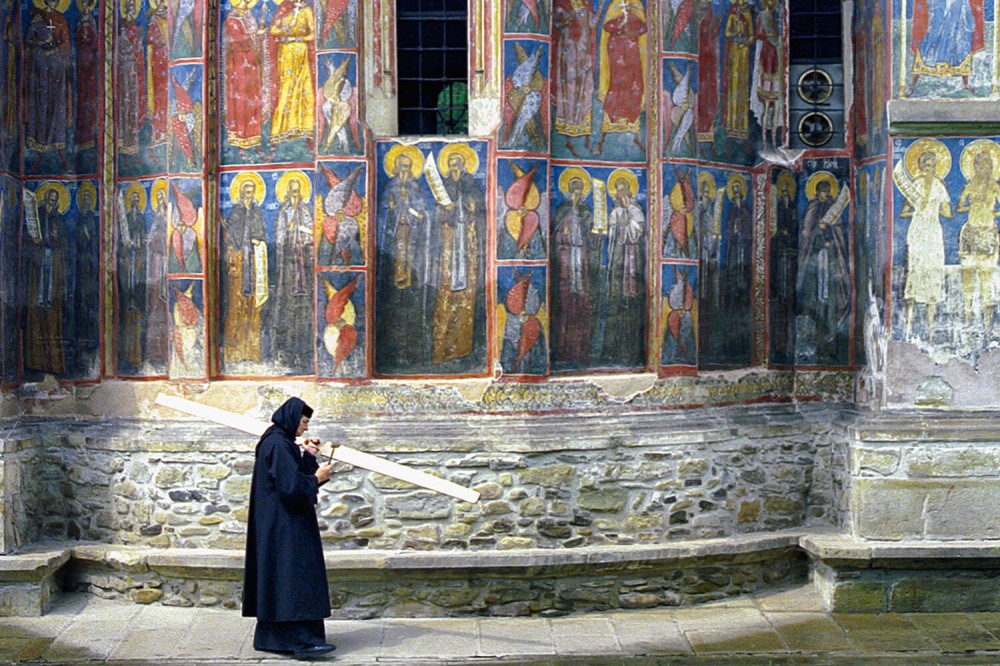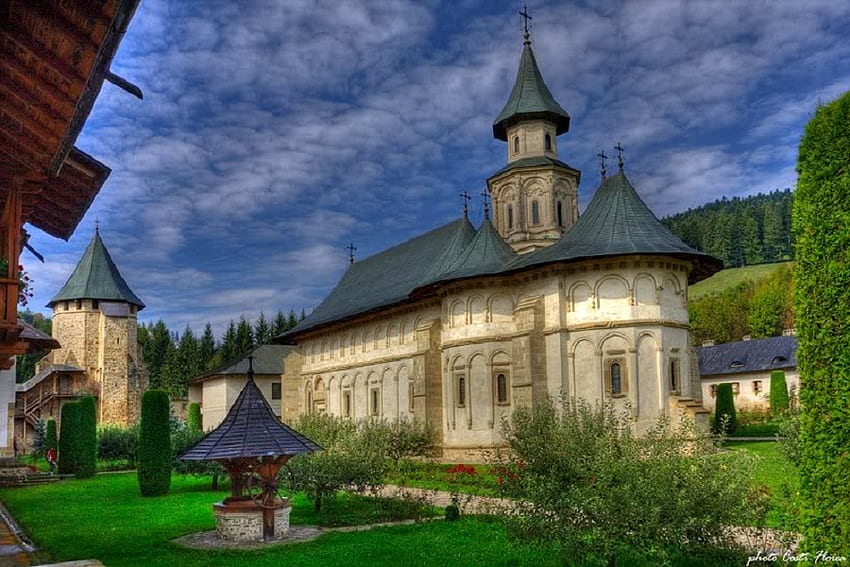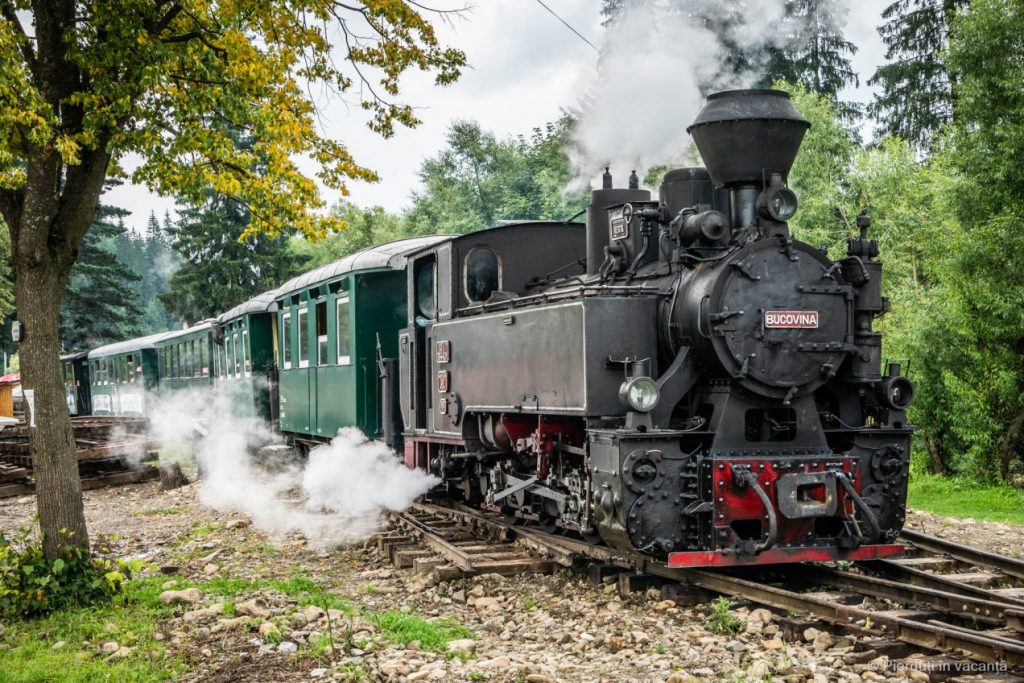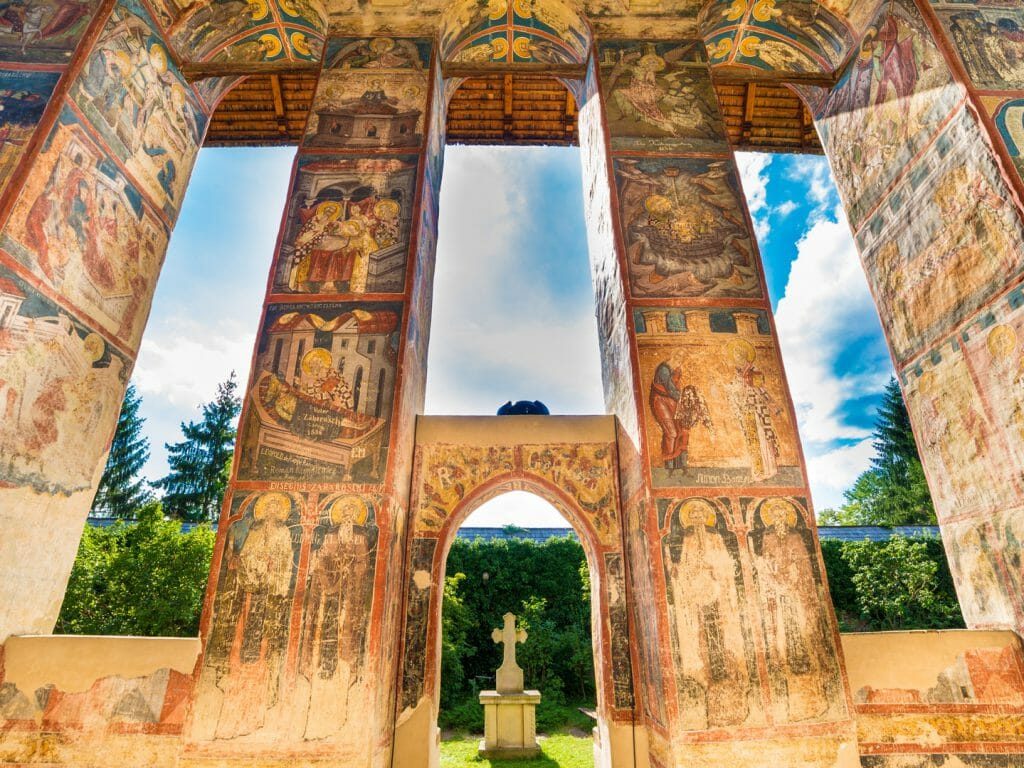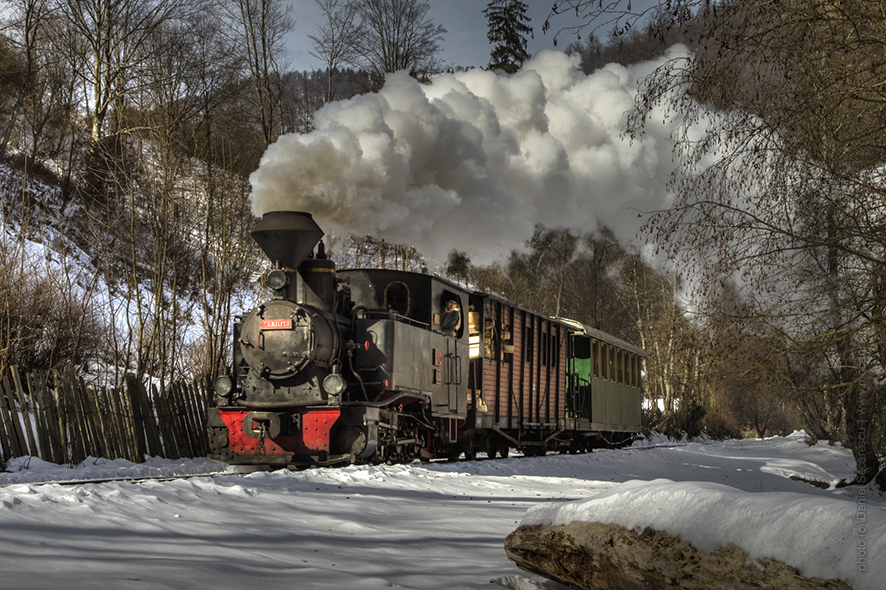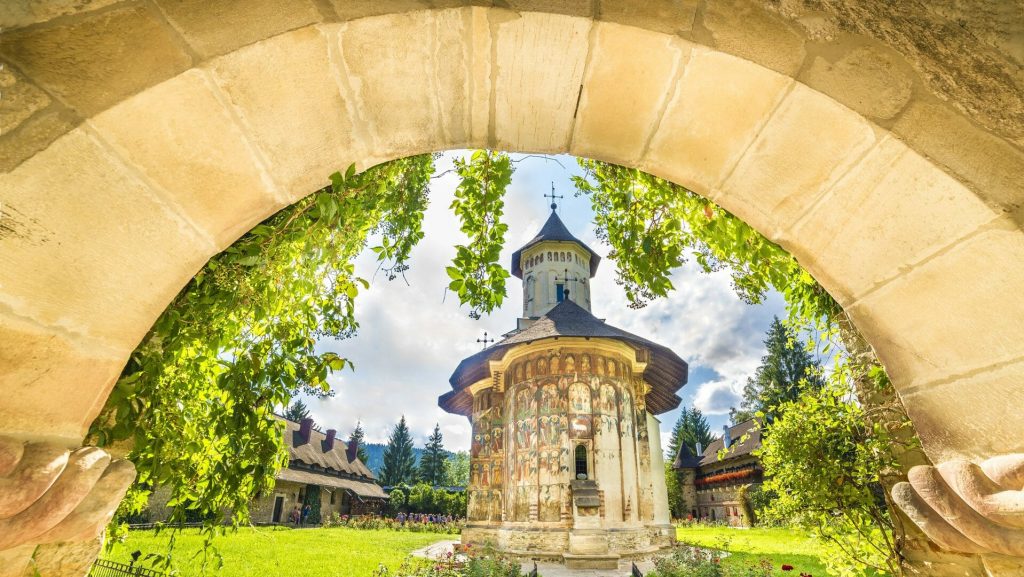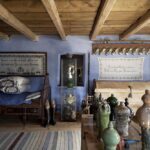Day 1 – Welcome To Bucovina
• The Voroneţ Monastery, also called “the Sistine Chapel of the East”, was built over 500 years ago in a record time, and that is, in just four months and two weeks. The place of worship was built by the ruler Stephen the Great (Ştefan cel Mare) on the ruins of an old Moldovan style church destroyed by the fire. Paintings on the exterior walls are truly remarkable. “Blue Voronet” is the predominant color and, to date, it is not known how it was created.
• Traditional lunch with Bucovina delicacies
• The first church at Varatec was a small church built out of wood. As the number of nuns grew, the wooden church was replaced by the existing church between 1808-1812, but painting and decoration continued until 1841. The second church, chronologically speaking, to be built as from 1808 was “the Assumption of the Virgin”. It was known and named by the community “the larger Church”. Its architecture preserves certain features taken up from the old church architecture and that of the 18th century in Moldavia
• Ruined and built again, burned and remade again, Agapia on the hill becomes a very charming hermitage. On the place of the church, built at the beginning of the 17th century, hetman Gavril, the brother of Vasile Lupu (Moldavian ruler), and his wife, Liliana, raised at Agapia from the Valley, in 1642, the Agapia Monastery. At the beginning of the 17th century, the monks from Old Agapia moved their house down the valley of Agapia brook, where they also built a small wooden church (the church „Saint Ioan Bogoslovul” from today)
• Accommodation, dinner and red wine
Day 2 – Legends & History
• Breakfast
• Romania is home to many stunning citadels and the Neamt Cidatel located in the Moldova region is one of them. The medieval citadel, overlooking the beautiful Moldova and Siret valleys, takes visitors back in time with its stories and the help of the recent EU-funded renovation. It is one of the most important tourist objectives in the region. Built in the 14th century Moldavia during Petru I of Moldavia’s reign, and expanded in the 15th century, the citadel played a key role in Moldavian Prince Stephen the Great’s defense system against the Ottomans, Hungarians and Poles. After Stephen the Great’s period of glory, the fortress continued to play a major role in the defense of Moldova, during the ruling of Bogdan III, Stefanita, and Petru Rares
• The church of the Sucevita Monastery was included on the UNESCO Heritage List on 1st of August 2010 and is the only church that includes a representation of The Ladder of St. John. The church was painted around 1595, nearly half a century after its “sister” churches. It is considered the last flowering of the custom of painting the church façades that mark the reigns of Stephen the Great and Petru Rareş. Building and painting a church that closely resembled the edifices their ancestors raised decades before, was a way for the Movilă to claim to be part of the royal line of Stephen the Great
• Traditional lunch with Bucovina delicacies
• Alexander the Kind built the first monastery in Moldoviţa on the banks of the Moldoviţa River at the beginning of the 15th century. The exterior paintings are the best preserved of all the churches of Bukovina. The church was painted in 1537 both inside and outside. The significant stylistic differences between various scenes indicate that there must have been several painters at work in Moldoviţa
• This Unesco-protected church in the village of Arbore receives a fraction of the visitors of the other painted monasteries and hence feels more private and special. The tiny interior consists of just three chambers. The chamber nearest the altar has a particularly well-preserved votive painting (on the facing wall) of Arbore and his family offering the church to God. The tombs of Arbore and his family sit in another chamber. The interior is in the process of long-term restoration and preservation. The exterior paintings on the western wall are in relatively good shape, while the paintings that once covered the rest of the outside have been lost to the ravages of time
• Enjoy the free time and dinner at the guesthouse
Day 3 – Steam Train & Marginea Village
• Beakfast
• You cannot leave Bukovina without trying at least once the experience of the steam train leaving from Moldovita. Named by the locals Hutulca, it represents an ideal opportunity for tourists to admire the beautiful natural landscapes of this part of Bukovina. The narrow-gauge railway from Moldovita was built by a sawmill owner in Munich, Louis Ortieb. It was put into service in 1888, for the transport of timber, from the forest to the sawmill. Hutulca from Moldovita runs today on a route of 12 km. Mocanita steam train holds both open and closed-topped coaches, following the tradition of Mocanita steam trains around the country. Hutulca is appreciated both by tourists and locals, crossing a significant part of the village, in front of the houses
• Traditional lunch in a special location
• The last stop of the day will be in Marginea village. The black pottery produced at the Marginea is known internationally, mainly due to its black color obtained following an ancient burning technique. Marginea became a pottery center somewhere in the 16th century. The ceramic was mainly crafted for food storage or other purposes. Marginea had about 60 families of potters and now there are only two to three families left
• We sleep in a guesthouse located in the heart of Bukovina and enjoy a delicious traditional dinner\
Day 4 – Stefan’s Fortresses
• Breakfast
• The Putna Monastery is one of the most beautiful of the Moldovian monasteries. Located 33 km north-west of the city of Rădăuţi, in Suceava County, it is one of the most important cultural, religious and artistic centers in Romania. The construction of the Putna Monastery commenced on the 10th of July 1466, after Stephen the Great conquered the Chilia Citadel, and were concluded in 1469, with the blessing service on the 3rd of September. A Romanian chronicler wrote that Stephen the Great chose the spot where to build the monastery by drawing his bow from a mountain top. And where the bow landed was where the monastery was built
• About 2 km from Putna, there is a cave that contains a wooden table and memorial plaque to the 15th-century hermit and seer Daniel Dimitru. A monk by age 16, Daniel later dug and inhabited this rock cave; his fame was such that Ştefan cel Mare consulted him before doing battle. From Putna Monastery, you can walk to the cave in about 30 minutes. Because of his fame, he chose to live in solitude and he spent more time for prayers. He caved the stone by himself. They say it took him 11 years to carve 9.25 m x 2 m. Voronet Monastery hosts Sf. Daniil’s remains which makes the subject of another pilgrimage. On December 18 the Orthodox Christians celebrate him as a Saint
• For an hour we stop and enjoy the lunch served in a surprise location
• Citadel of Suceava was part of the fortification system constructed in Moldova in the late fourteenth century, during the Ottoman threat. The medieval fortification system was composed of fortified settlements (princely courts, monasteries with high walls and fortresses of strategic importance) for defense, strengthened with stone walls, earth walls or having deep grooves. The citadel was built in the late fourteenth century by Peter I Musat and fortified in the fifteenth century by Stephen the Great
• In the evening we enjoy the time and the traditional dinner at a beautiful guesthouse
Day 5 – Traditions And Stories
• Breakfast
• Egg Museum, Bukovina. Deep in the heart of Bukovina, in Vama, we are waiting for you to see the most varied and numerous collections of painted and decorated eggs in Romania and one of the most important ones in Europe at once. The museum is also helpful to discover the traditions from the area and the art of decorating the Easter eggs. Inside the workshop you can also decorate eggs yourself directed by the teacher Letitia Orsivschi, who is going to explain you the hidden symbols of Bukovina. In the museum there are over 7,000 eggs from all over the world displayed in 22 glass-cases; there you can admire eggs collected from international exhibitions (as a result of 14 year-long personal participation at different international exhibitions) and eggs from Bukovina with unique, old motifs and patterns inherited from our great-grandparents
• The general image of Bukovina Village Museum reflects the organization and the complex activity of the traditional village, the vernacular architecture of the households and of the community constructions, of the technical facilities which illustrate the occupations and crafts in the area and the way of life of the Bukovina dwellers. Next to the households formed by houses and annexes located along the narrow street, in the center of the village, as central point of the life of the community, there can be found the Vama church and bell tower, the Șaru Dornei public house and the Securiceni school
• Before leaving to Bucharest we stop at the restaurant to serve lunch
• Arrival to Bucharest and hotel transfer
IMPORTANT NOTE:
- Sometimes, some of the places we intend to visit may be closed at that time. But don’t worry. We have prepared tourist attractions at least as interesting as the previous ones.
- We can organize this tour all year long.
- The tour can be optimized according to your wishes.
—————————————————————–
Talk to our tours expert
We are here to discuss about your next dream trip in Romania!
We can organize this tour all year long. The tour can be customized depending on the number of days you have available.
- call us : +40761.896.881 or just write us on whats app
- 9 am – 8 pm Monday through Sunday.
Otherwise, send an email anytime: office@wildromania.ro
For booking please contact us with at least 3 months in advance in the extra season and at least 5-6 months in advance during the full season (in the summer time), to check the availability. We will offer our support for all the aspects related to the trip planning, including the flight schedule.
All you have to do is to contact us as soon as possible, in order to have enough time at disposal for all the organizational details.


